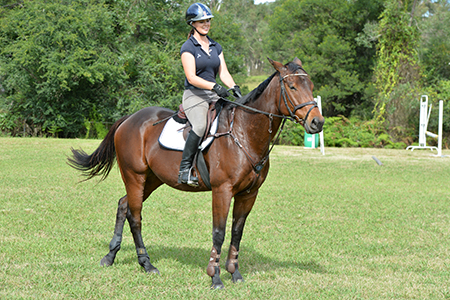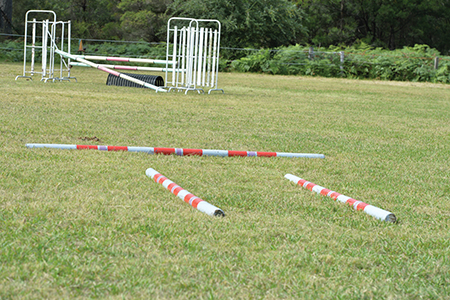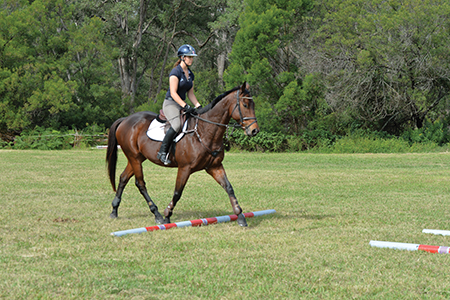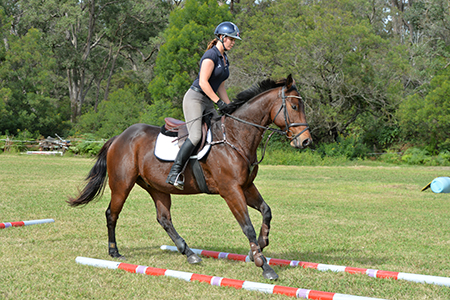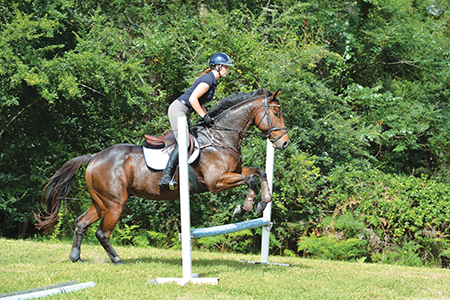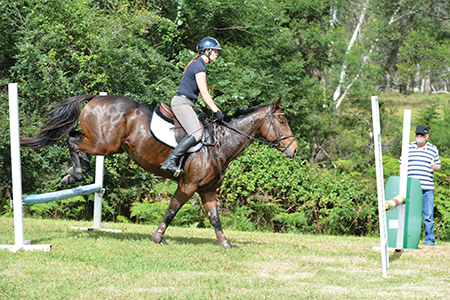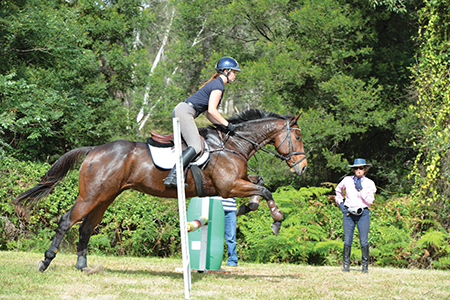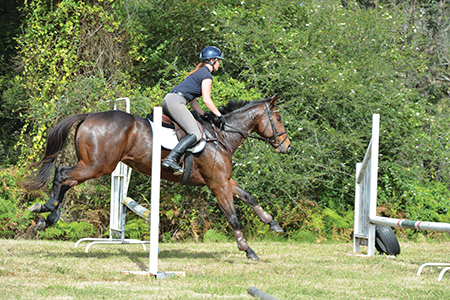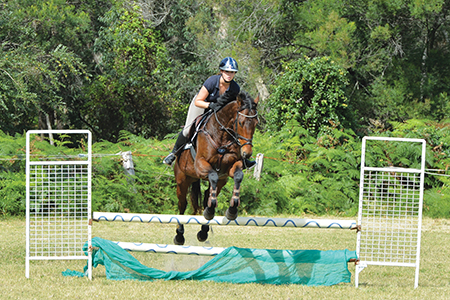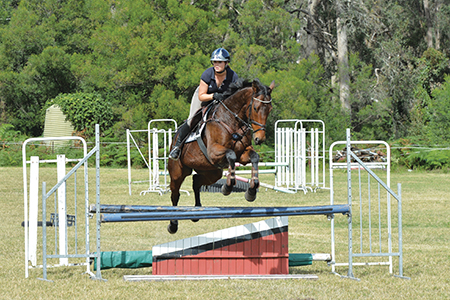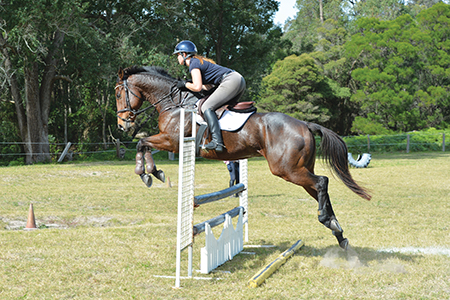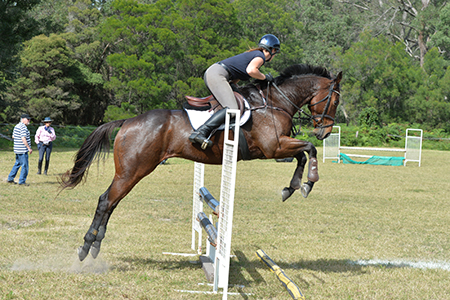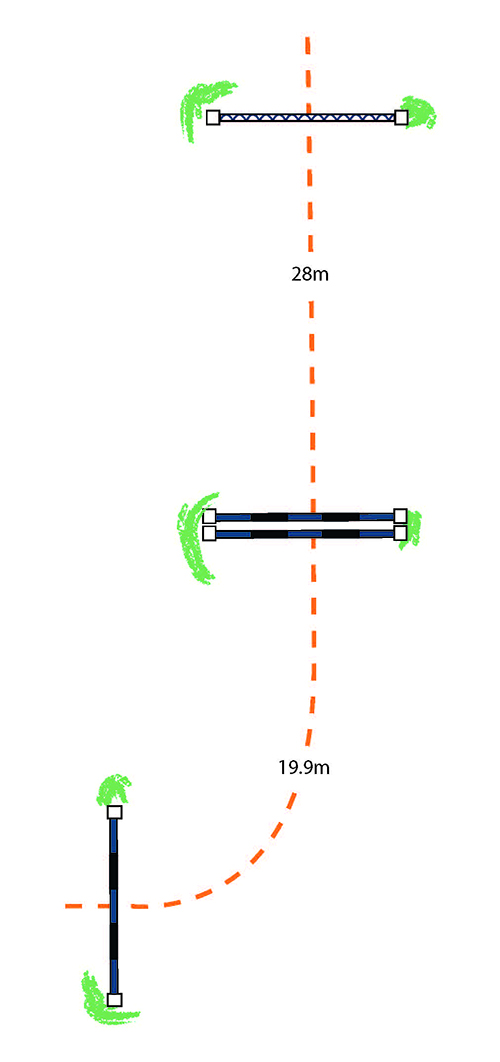Jumping trainer and all-round horse person, Colleen Brook helps her daughter Liz Koob, as she accustoms Illumination to his new life off-the-track… Illumination is by Encosta de Lago, from a mare with Biscay and In the Purple bloodlines. He is six years old and about 16 hands.
Colleen says he has been a delight to work with: “He has a lovely nature and he is jumping 90cm -1m. Liz rode him in a one-day event last week and he galloped very well. She said he gave her a good ride around the cross country.”
The Format:
The session started with a simple exercise – turn on the forehand – we see various forms of this exercise at the beginning of many lessons. It’s very good for horses like Illumination, Colleen tells us, it gets the horse listening to the rider’s leg, something racehorses are not so used to…
“The horse learns to respond to a single leg aid. First the horse must move the hind leg across, then turn around the forehand step by step. A quarter turn is two steps, start with small expectations and your horse will have a go. It is the rider’s timing that is crucial to the success of any exercise. The rider must not contort their body and the horse must move his.”
Liz looks happy with what is happening so far, it is early days.
How long does it take before the horse looks like the finished article?
“That depends how consistent and patient the rider is. A tense tight rider is not going to be able to feel what the horse is offering. Be happy with small gains, lots of small gains add up. When you start to teach your horse this exercise, you must ask consistently with the same aids on the same side and repeat until the horse offers promptly, only then should you teach the exercise on the other side.”
“Hopefully you might go for a trot before you tackle the other side or better still wait until another day… Normally it is the rider who runs out of patience first.”
“The horse has learned the exercise when you can repeat it without major mistakes. Every book, every trainer, I have ever read /listened to has given that sort of advice about training horses/people.”
Going Straight:
Colleen stresses that straight lines and turns need to be schooled at home:
“Jumping riders usually train in a big area, and accuracy, or the lack of it, becomes an issue. Lots of circles are ridden, but not many turns or straight lines. The T poles give you a specific place to do something. The two poles side by side are approximately 1m – 1.10m apart, the third pole forming the T is 2m away. You can practice transitions through the two poles to help keep you straight, use them like dressage markers. We train walk, halts, rein back between those poles, you can trot the T rail and halt between the two poles. Canter over the pole, transition down to trot either way, keep the eyes up and forward. Light seat, upright seat, you can trot across the two poles slowly pick up canter and ride through the two poles. You can angle the single pole either way. I love the pole work, that is my dressage!”
Pole Position:
“Liz is trotting over the poles and her position with her upper body is good. The rider must be leaning forward in front of the vertical so any upward lift by the horse to go over poles is easy for the rider to absorb. If the rider is upright they will fall behind the movement, pull on the reins for balance and bang on the horse’s back. Liz’s reins need to be shortened by 5cm to have the perfect mouth, hand, elbow line. Her eyes are good, if we are particular, she could allowing more weight down into her heels so her heels are lower than her toes. Yes, always practicing.”
Exercise: The Bounce
The distance between fences is 3m, 3.30m, 3.50m, or in old speak 10/11/12 feet.
“We trot into bounces first to teach the horse, then we can canter in.”
“Today we’ll start in a nice relaxed canter, then it is get yourself organized for the bounce. Just stay behind him a little more, coming into the first of the bounces, just keep your legs around him, and let him sort it out. Horses will back off coming into the first of a group of jumps.”
Rider Critique 1: “Liz’s eyes are good, the hand contact is good. The upper body is a little ahead of the knee, (shoulders-knees-toes). Remember I said about how easy it is to be ahead. Her hands could be a 5 – 10cm further forward and down and the lower leg further forward, close to the girth and close around the horse. Despite those things she looks comfortable, balanced, and the horse is straight with enough impulsion.”
Rider Critique 2:
“Looking at the lines for the rider, horse’s mouth, hand, elbow, rider’s shoulder, knee, toe I think she is very close to the ideal, the horse is at a critical balance moment and the rider is doing her best to be in the middle and ready to push if necessary.”
Rider Critique 3:
“Liz has a nice flat back, hands are good, the lower leg has slipped back which has allowed the upper body to be a little ahead. The horse has a pleasant look on his face and is concentrating well, still straight.”
What can we improve?
“We are able to really zoom in on the position. The lower leg would be the major thing to work on for the rider. The horse looks comfortable, not rushing or crooked, his shape could be rounder and the front legs tighter but interestingly if you see how far his body is above the jump, then all things considered, it’s not too bad.”
“I wouldn’t shorten the distance to make it harder to make the horse jump better for a green horse because they start to hang their front legs, rush, twist, and get anxious. None of which is what we want. For a really big horse or big strider, I would have all the distances in the bounce at 3.50 metres. You can see he is still in the learning phase, looking confident, ears pricked, figuring it out and ready to move on…good boy.”
Why that exercise?
“Everybody has their favorite exercise, and man-oh-man, there are just so many exercises, so it’s really a matter of pick this one for this week, and that one next week.”
“Usually after a competition I find that I am a bit ahead with my upper body, and I need to come back and keep the shoulders up – that’s why these exercises are great. I love the trotting in exercises to get the rider, not back in the saddle, but back in the middle of the horse. Competition gets you moving, schooling at home is where you go back a step and tidy up the small details.”
Up the hill – and down the hill:
“Let’s do our favorite line, up the hill and the turn. We jump the little vertical straight ahead to the blue and black, then a right hand turn to the other blue and black. It’s the usual thing, set your pace and let your pace take you up the line and then ride forward through the turn. The actual distance is a seven and a five stride. If for the first time or two, you don’t get it that way, it doesn’t matter, just repeat it until you learn/feel how much leg and hand is needed to make it happen how you planned it. The aim is to be able to repeat at will.”
Rider Critique 1:
Small vertical with shade cloth draped over bottom rail. “Rider’s eyes good, horse straight, rider hands and lower leg similar to the bounce pics.”
Rider Critique 2:
“Rider’s eyes looking for next fence through the turn. Rider’s legs could be more around the horse as he is not quite straight between the rider’s legs – which would also keep the impulsion in the jump.”
Rider Critique 3:
“Best pic of the three, horse looking straight and jumping with impulsion. The rider is balanced in the middle. Hands could be further forward, always look for the mouth, hand, elbow line. Should I mention the lower leg? In my photos my lower leg comes back, aargh. The horse has one back leg leaving the ground before the other so he is not quite balanced, he should push off with both back legs for maximum thrust, like he does over fence 4.”
Rider Critique 4:
“Very similar from both rider and horse so that tells me there is consistency.”
What can we improve?
“Overall just some tidy-ups are required to improve the connection on the flat (leg security). The horse appears to be happy about jumping from his expression and showing confidence so this combination look to be ready to do more.”
Turn turn turn
“I love something off a short turn and I always have that in the paddock. I really like that exercise because gets the rider looking early, riding an accurate line as it makes them ride forward through the turn. Some people like to ride under the pace at the start, if you have a really hot horse it is ok, but most horses will relax when you aren’t pulling at them all the time – it’s not surprising, it’s logical.”
“The turn there is on the home corner, it has everything we find tough on the competition course, it’s all there – you can turn short after the jump left or right. You need to practice turns. When we do the George Morris clinics we do lots of turns. It certainly gets the horses listening and ready. I do not like to see horses being pulled around the turns. Pushing with an allowing rein is better for the engine and straightness. Turns keep the riders thinking ahead too and doing something positive after the jump.”
“Departures from fences are often neglected . As soon as you say to a rider: go straight four strides/six strides after the turn, it immediately gives them something to think about. For too many people, the focus is only on the approach. The get away/departure is part of jumping a fence too, because it is the approach to the next fence.”
“Among the many things I have learned from George Morris is that you don’t spend all your time trying to get a perfect distance to a fence, yes it is a skill you need to master, but it is not the only one…”
“Balance is needed – of course – and work with the take offs: open, closed (short), medium, be flexible… I have seen too many riders worry about the take off and become obsessed about the distance and ignore most of the rest, that is not a recipe for success. When you go faster or on a cross country course, because of the extra speed, you do end up in some take off places you never thought you would end up in, and horses are wonderful as they are just get on with it.”
“You like to give horses a smooth ride, but things do go wrong, and you have to be able to be flexible and cope. I love good corners and angles when I am teaching a group – even riders who are a little green – I say, see that fence there, come towards me on an angle. Their faces pale, GULP. It can be really low, but it does is get them focused and straight, and they are amazed how well they go. Proof of a plan, visual cues are good, cones for example help keep the riders focused.”
The Jumps
The jumps should be built to be able to jump both directions, so a ground line on both sides.
The distance between the jumps on the straight line is 28m, a steady 7 stride, and the curve is 19.90m, a steady 5 stride. These distances are 90cm short of a ‘true’ distance because the heights of the jumps are less than 1m. In old speak the distance is 27 steps and 23 steps of 90cm or one yard.
The reason to shorten under 1m is the take off, flight and landing are shorter than for bigger jumps. Our job is to keep the canter stride balanced, with us positioned in the centre of the horse.
Genuine big striders will find most distances too short for them and they will slow their stride without impulsion with a launch or a blob. The horse might even tangle their back legs a bit on take off over the jump from the lack of impulsion. The rider needs to be ready with their legs to keep the canter as active as they can in that instance.
Some horses do not need much support from the riders’ legs at all.
If a horse wants to run at the second fence, jump into the line and stop repeatedly (halt for at least 30 seconds each time) until the horse waits on landing and is less excitable.
The curve is great for riders to think forward and get it done. Too much rein pulling without support of the legs and the horse will resist. This results in a poor shape turn and maybe we miss the fence altogether. When the rider gets into the habit of mentally pushing, with the body supporting, corners are great.
There is no need to angle the jumps ready for the turn, this exercise concentrates on 90 degree turns.
Too many riders are slow to look through the turn. Riders also get halfway through the turn, give up and pull out trying to make the turn, which confuses the horse . So look ahead and ‘ride’ the horse through the turn.
The number of strides gives you a guide about your pace, the first few times they are all over the place. Take a few deep breaths and have another go. If the area you have to train in is small, try with rails first, or cavalletti.
Exercises to help improve the rider’s leg:
- Sitting trot with and without stirrups, regularly.
- Trot in to small jumps concentrating on heels down, only.
- Rein release practice, the hands forward and down towards the horses’ mouth will also help the rider stabilize and rely on the leg for support.
The rider’s position is all interconnected.


